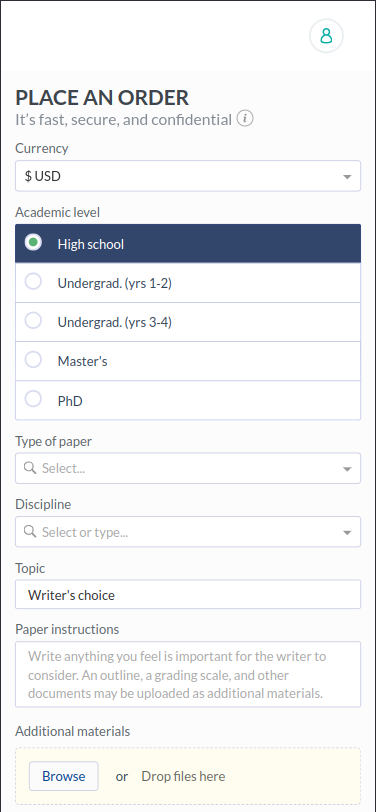NR 599 Week 5 Assignment
Clinical Decision Support Systems
Purpose
The ideas and beliefs underpinning the discussions guide students through engaging dialogues as they achieve the desired learning outcomes/competencies associated with their course in a manner that empowers them to organize, integrate, apply and critically appraise their knowledge to their selected field of practice. The ebb and flow of a discussion is based upon the composition of student and faculty interaction in the quest for relevant scholarship.
Activity Learning Outcomes
Through this discussion, the student will demonstrate the ability to:
- Contribute level-appropriate knowledge and experience to the topic in a discussion environment that models professional and social interaction (CO4)
- Actively engage in the written ideas of others by carefully reading, researching, reflecting, and responding to the contributions of their peers and course faculty (CO5)
Due Date:
Students must post a minimum of 3 times in each graded discussion. The 3 posts in each individual discussion must be on separate days. Posting 3 times on 3 different days meets the minimum requirement for full credit; each post must be substantive. The student must provide an initial post to each graded discussion topic posted by the course instructor, by Wednesday, 11:59 p.m. MT of Week 5. Subsequent posts, including essential responses to peers, must occur no later than the Sunday, 11:59 p.m. MT at the end of Week 5. Students are expected to submit assignments by the time they are due. Threaded discussions are not considered assignments and are not part of the late assignment policy.
A 10% late penalty will be imposed for discussions posted after the deadline on Wednesday regardless of the number of days late. NOTHING will be accepted after 11:59pm MT on Sunday (i.e. student will receive an automatic 0).
Total Points Possible: 150 Points
Requirements:
Post a written response in the discussion forum to EACH threaded discussion topic:
- This week we learned about the potential benefits and drawbacks to clinical decision support systems (CDSSs). Create a “Pros” versus “Cons” table with a column for “Pro” and a separate column for “Con”. Include at least 3 items for each column. Next to each item, provide a brief rationale as to why you included it on the respective list.
- The primary goal of a CDSS is to leverage data and the scientific evidence to help guide appropriate decision making. CDSSs directly assist the clinician in making decisions about specific patients. For this discussion thread post, you are to assume your future role as an APN and create a clinical patient and scenario to illustrate an exemplary depiction of how a CDSS might influence your decision. This post is an opportunity for you to be innovative, so have fun!
Adhere to the following guidelines regarding quality for the threaded discussions in Canvas:
-
- Application of Course Knowledge: Demonstrate the ability to analyze, synthesize, and/or apply principles and concepts learned in the course lesson and outside readings.
- Scholarliness and Scholarly Sources: Demonstrates achievement of scholarly inquiry for professional and academic decisions using valid, relevant, and reliable outside scholarly source to contribute to the discussion thread.
- Writing Mechanics: Grammar, spelling, syntax, and punctuation are accurate. In-text and reference citations should be formatted using correct APA guidelines.
- Direct Quotes: Good writing calls for the limited use of direct quotes. Direct quotes in discussions are to be limited to one short quotation (not to exceed 15 words). The quote must add substantively to the discussion. Points will be deducted under the grammar, syntax, APA category.
For each threaded discussion per week, the student will select no less than TWO scholarly sources to support the initial discussion post.
Scholarly Sources: Only scholarly sources are acceptable for citation and reference in this course. These include peer-reviewed publications, government reports, or sources written by a professional or scholar in the field. The textbooks and lessons are NOT considered to be outside scholarly sources. For the threaded discussions and reflection posts, reputable internet sources such as websites by government agencies (URL ends in .gov) and respected organizations (often ends in .org) can be counted as scholarly sources. The best outside scholarly source to use is a peer-reviewed nursing journal. You are encouraged to use the Chamberlain library and search one of the available databases for a peer-reviewed journal article. The following sources should not be used: Wikipedia, Wikis, or blogs. These websites are not considered scholarly as anyone can add to these. Please be aware that .com websites can vary in scholarship and quality. For example, the American Heart Association is a .com site with scholarship and quality. It is the responsibility of the student to determine the scholarship and quality of any .com site. Ask your instructor before using any site if you are unsure. Points will be deducted from the rubric if the site does not demonstrate scholarship or quality. Current outside scholarly sources must be published with the last 5 years. Instructor permission must be obtained BEFORE the assignment is due if using a source that is older than 5 years.
Sample Discussion Post
|
PROS |
CONS |
|
1. Drug interaction alerts- Helpful when prescribing new medications as a way to determine if medication will have a negative impact on the patient. |
1. Trends in clinical values- When obtaining multiple labs, procedure and blood work, this would assist the healthcare team to determine trends either up or down while looking at the whole picture. |
|
2. Next-Step treatment options- Helpful when unsure what next steps in a patients care should be. |
2. Financial Implication- Having an electronic health record can be costly to physician practices or hospitals depending on clinic and patient case load. |
|
3. Trends in clinical values- When obtaining multiple labs, procedure and blood work, this would assist the healthcare team to determine trends either up or down while looking at the whole picture. |
3. System Failure- This can happen in a multitude of ways including no internet connection, server connectivity issues or system wide failure. This poses a potential concern if the physician practice does not have a back-up method for interacting and treating patients. |
Clinical decision support systems (CDSS) is a great tool to assist health care providers in providing either computerized or non-computerized interventions (Wasylewicz & Scheepers-Hoeks, 2018). This information is gathered through multiple facets and then notifies the physician of any changes or possible changes to a patients’ health.
Scenario: My patient is a 32-year-old male named Derek who presented for major depression, anxiety, and possible bi-polar disorder. Derek is on several medications which include: Zoloft, Xanax, Trazodone, and Abilify. Derek is also obese with a BMI of 43. Derek states that he doesn’t eat well, no exercise and is currently going through a divorce. When I asked how long he has been on these medications, he isn’t sure. When I asked who prescribed them, he informs me that he has been to several physicians over the past year and just keeps taking whatever medication they prescribe without stopping or asking about previousmedications. Derek hasn’t had a physical in over 10 years and admits to
smoking and drinking heavily.
When inputting all of this information into my work flow data base, red flags keep popping up. The red flags indicate that the patient has several high risk indicators for further medical concerns. Some of the alerts that pop up are medication interaction, comorbidities, alerts for bloodwork that need completed and a full physical health assessment. I am also alerted to the fact that he has seen
multiple physicians, however since they don’t use the same electronic health record, Derek’s information does not ‘flow’ from one physician practice to another, therefore vital information is being looked over or not completed because Derek is not a very good historian. The lack of information given and the comorbidities along with smoking and drinking pose a huge threat to Derek’s health and well-being.
Using the CDSS would be extremely helpful in this situation as it pinpoints all major areas for concern and even makes suggestions as to what action steps should be taken next. Unfortunately, this scenario is all too familiar when it comes to the health care some individuals receive. Having useful tools such as the CDSS can truly assist providers and future providers, like myself, in making informed and complex decisions about patient care (Sutton et al., 2020).
References
Sutton, R. T., Pincock, D., Baumgart, D. C., Sadowski, D. C., Fedorak, R. N., & Kroeker, K. I. (2020). An overview of clinical decision support systems: benefits, risks, and strategies for
success. NPJ digital medicine, 3, 17. https://doi.org/10.1038/s41746-020-0221-y
Wasylewicz ATM, Scheepers-Hoeks AMJW. Clinical Decision Support Systems. 2018 Dec 22. In: Kubben P,Dumontier M, Dekker A, editors. Fundamentals of Clinical Data Science [Internet].
Cham (CH): Springer; 2019. Chapter 11. Available from: https://www.ncbi.nlm.nih.gov/books/NBK543516/ doi:10.1007/978-3-319-99713-1_11




